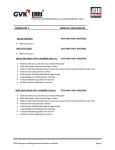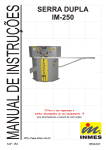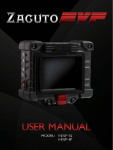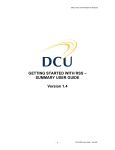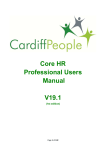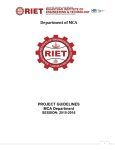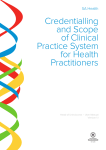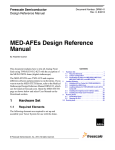Download Curriculum for Motorcycle Mechanic
Transcript
Curriculum for Motorcycle Mechanic (6 Months) Page 1 Contents Overall objective of the course: ………………………………………………………………………… Competencies gained after completion of the course: ………………………………………………. Job opportunities available immediately and in the future: ………………………………………….. Curriculum salient points: ……………………………………………………………………………….. Overview about the program: …………………………………………………………………………… Module 1: Automotive workshop basic……………………………………………………. Module 2: Application of the related study……………………………………………….. Module 3: Power generation system……………………………………………………… Module 4: Power transmission system……………………………………………………. Module 5: Chassis of Motorcycle………………………………………………………….. Module 6: Electrical system of motorcycle……………………………………………….. Module 7: Service of the Motorcycle and engine overhauling………………………….. Assessment Module 1: Automotive workshop basic……………………………………………………. Module 2: Application of the related study………………………………………………… Module 3: Power generation system………………………………………………………. Module 4: Power transmission system…………………………………………………….. Module 5: Chassis of Motorcycle…………………………………………………………… Module 6: Electrical system of motorcycle………………………………………………… Module 7: Service of the Motorcycle and engine overhauling…………………………… Supporting notes:………………………………………………………………………………………….. List of material:…………………………………………………………………………………………….. List of equipment:………………………………………………………………………………………….. List of tools:…………………………………………………………………………………………………. Page 2 3 3 4 4 6 7 9 10 13 14 16 17 20 21 22 25 26 27 28 31 33 33 34 Overall objective To prepared and train a student to become a motorcycle mechanic to earn a respectable living and learners will be able to work as skilled worker. Competencies gained after completion of course: 1. 2. 3. 4. 5. 6. 7. 8. 9. 10. 11. 12. 13. 14. 15. 16. 17. Page 3 To apply safety precaution. Explain the common hand tools, special tools and measuring tools. Select, use and handle auto motive hand tools work shop tools, equipments efficiently. Observe safety measures. Basic mathematically calculation. Explain the internal combustion engine and external combustion engine. Explain the four strokes and two strokes engine of motorcycle. Remove, dismantle, inspect, refit install engine parts. Set the valve timing of four strokes motorcycle engine. Explain purpose of different system of motorcycle. Service and maintenance of fuel system / cooling system / lubrication system / starting system and ignition system. Service and maintenance of clutch / gear box and drive chain. Service and maintenance steering and suspension system / brake system and wheel Service and maintenance charging system and battery. Install and repair / maintenance of electric wiring / replacing bulbs horns fuse. Service / tuning and overhauling of motorcycle engine. Diagnose the engine troubles. Job opportunities available immediately and in the future: The pass outs of this course would be able to: Work in manufacturing industry / assembling plant of motorcycle. Work in repairing / service shops of motorcycle. Start own shop of motorcycle repair / service / maintenance. Government department. Motorcycle dealerships. Spare parts stores. Curriculum Salient Points Entry level: Middle / preferable Metric. Admission is subject to passing a general aptitude test. Class size: 16 – 20 Trainees. Duration of course: 06 – Months 800 hours 40 hours per week 06 days a week 07 hours per day Except Friday 05 hours Training methodology: Practical Theory Page 4 80 % 20 % Medium of instruction: Urdu / English Evaluation: Attendance, sessional / final test Grade: Theory: Practical: Pass marks Pass marks Very good Good Average Fail 93 ----- 100 % 79 ------ 92 % 60 ------78 % 0 ------ 59 % Page 5 40 % 60 % Overview about the program – Curriculum for Motorcycle mechanic Module Title and Aim Module 1- Auto motive workshop basic. Aim: To apply the safety precaution and use the tool properly Module 2 - Application of related study. Aim: Apply mathematically and drawing basic role in general routine and market Module 3 - Power generation system Aim: Understand the working of motor cycle engine and repair /maintain the engine and all systems. Module 4 - Power transmission system. Aim: Understand the working of power transmission system and repair / maintain all components of transmission. Module 5 - Chassis of motorcycle Aim: to understand / diagnose and service steering / suspension and break system. Module 6 - Electrical system of motorcycle Aim: electrical system of motorcycle system / to diagnose and repair all electrical system. Module 7 – Service of motorcycle and engine overhauling Aim: Understand / service of the motorcycle / complete overhauling of engine / diagnosing engine fault. Page 6 Learning Units Theory hours Workplace hours 1.1 Describe and apply safety precaution and safe riding 1.2 Use of tools and tools introduction. 1.3 Basic mettle work exercise 1.4 Explain history of motorcycle 2.1 Technical mathematic exercise 2.2 Technical drawing 20 140 40 10 3.1 Introduction repair and maintain motorcycle engine 3.2 Introduction / repair and maintain motor cycle fuel system. 3.3 Introduction repair and maintain lubrication system of motorcycle. 3.4 Introduction repair and maintain motorcycle cooling system. 3.5 Service of engine exhaust system. 3.6 Introduction repair and maintain motorcycle ignition system. 4.1 Introduction and repair and maintain motorcycle clutch assembly. 4.2 Introduction and repair and maintain motorcycle gear box 4.3 Service transmission chain assembly. 4.4 Service mechanical starting system. 5.1 Introduction / repair and maintain steering and suspension system. 5.2 Introduction / repair and maintain motorcycle braking system and wheels. 6.1 Introduction / repair and maintain motorcycle charging system. 6.2 Repair and maintain lighting system and accessories. 43 150 15 105 7 35 7.1 Service work of motorcycle. 7.2 Engine tuning 7.3 Engine top overhauling. 7.4 Procedure of complete engine overhauling. 7.5 Fault finding and their remedies 15 120 Motorcycle Mechanic Curriculum Contents (Teaching and Learning Guide) Module 1 title: Auto motive workshop basic Objective of module: To apply the safety precaution and use the tool properly. Duration: - 160 hours Theory: - 20 hours Practical: - 140 hours Learning units Learning Learning elements outcomes 1.1 Describe and apply safety precaution and safe riding 1.2 Use of tools and tools introduction. 1.3 Basic mettle work exercise Page 7 Develop safe working habits Evaluate and control hazard and risk. Maintain occupational health and safety awareness. Select / use and handle the hand tools properly. Identify and use the work shop tools efficiently and safely. Select measuring instrument and carry out measurement and calculation. To apply the basic machine shop hands technique. Describe personal safety. Describe tools for safety. Explain motorcycle safety. Demonstrate safety riding for motorcycle. Explain safety during service work of motorcycle. Uses of general tools screw drivers, spanners, wrenches, Allen key, pliers, pullers, hammer. Uses of special tools. tappet adjuster, fly wheel puller, clutch holder, valve guide remover, valve guide driver, valve spring compressor, pin spanner, ball race driver, bearing driver (rear / front) fork seal driver, rear / front shock absorber, disassembling tool, timing gear removing puller and refitting tools. Use of measuring tools. Steel foot rules, vernier calipers micrometer, dial gauges, cylinder gauges, thickness gauges, tire pressure gauge, torque wrenches, compression gauge, vacuum gauge, Wire gauge Cutting exercise (with hand hacksaw) Filing exercise Drilling exercise Threading exercise (with dies / taps) Extraction exercise Duration 04 hours 04 hours 02 hours 05 hours Material required Learning place Relevant teaching aid. Service manual. Classroom, workshop / lab. General tools. Special tools. Measuring tools. Classroom, workshop / lab. Mild steel 25x40x100. Unthreaded hexagon bolt. Hacksaw blade. Classroom, workshop / lab. 05 hours 25 hours 25 hours 25 hours 10 hours 15 hours 15 hours 10 hours 1.4 Explain history of motorcycle Page 8 To increase interest and knowledge in motor cycle technology. Explain the history of two stroke motorcycle. Explain the history of four stroke motorcycle. Identify the motorcycle parts. 05 hours 04 hours 04 hours 02 hour Motorcycle history sheet Classroom, workshop / lab. Module 2 title: Application of related study Objective of module: Apply mathematically and drawing basic role in general routine and market. Duration: 50 hours Theory: 40 hours Practical: 10 hours Learning units Learning Learning elements Duration outcomes 2.1 Technical mathematic exercise 2.2 Technical drawing Page 9 To solve the mathematically problems related to trade Identify and draw the diagram / symbols of motorcycle system. Calculating addition, subtraction, multiplication, division and calculating with brackets. Calculation of percentage / percentage value and basic value. Units of technical engineering. S I units, length, circumference areas, volumes, units of time. Calculate the circumference, circular areas, and cylinder volumes. Calculate fuel consumption per liter. Explain / calculate electrical units, ohm’s law, capacity of battery 05 hours Describe and meaning, importance use of technical drawing. Describe the type of basic line. Describe angles, triangles and circle element. Draw basic lines. Draw different type of angles, triangle and elements of circle. Draw the different symbols relating to motorcycle field. 06 hours Material required Learning place Out line and Note book Class room Drawing book / led pencil Class room 02 hours 03 hours 10 hours 02 hours 03 hours 02 hours 07 hours 03 hours 04 hours 03 hours Module 3 title: Power generation system (engine) Objective of the Module: Understand the working of motor cycle engine and repair /maintain the engine and all systems. Duration: 193 hours Theory: 43 hours Practice: 150 hours Learning Unit Learning Outcomes Learning Elements Duration Material Learning Required Place 3.1: Introduction repair and maintain motorcycle engine 3.2: Introduction / repair and maintain motor cycle fuel system. Page 10 Explain the operating principle of two stroke and four stroke engine and its components. Repair and maintain all system of engine. This competency covers the ability to service the fuel system and make repair and adjustment on its components. Describe working principle of two stroke cycle and four stroke cycle engines. Describe engine components and their function. Identify cylinder head and valves. Explain engine valve timing and its importance. Systematic method of removing an engine from a motorcycle. Disassembling two stroke and four stroke engine Checking parts wear, crack, bending, rust, corrosion, water and oil leaks, color, carbon, overheating, balance, clearance. Checking of engine parts with micrometer dial gauge and feeler gauge. Assembling an engine. Setting and checking of engine valve timing. Setting and checking ignition timing Explain working principle of fuel system Describe the main components of fuel system. Explain working principle of carburetor. Explain the types of carburetor. Explain the carburetor circuits. Explain the trouble shooting of fuel system. Service / checking / maintain components of fuel system of motor cycle. Disassembling and assembling the carburetor. 04 hours 06 hours 02 hours 02 hours 08 hours 07 hours 05 hours White board / Marker Tool kit Petrol Engine overhauling kit Kerosene oil Micrometer dial gauge and feeler gauge. ignition timing gun Class room Work shop / lab 06 hours 02 hours 02 hours 02 hours 02 hours 02 hours 02 hours 02 hours 10 hours 08 hours 07 hours White board / Marker Tool kit Carburetor repair kit petrol Petrol RPM meter Class room Work shop / lab 3.3. Introduction repair and maintain lubrication system of motorcycle. 3.4: Introduction repair and maintain motorcycle cooling system. This competency covers the ability to service the lubrication system. It includes the inspection of engine oil level, checking of air pump, oil filter and oil pressure. Inspection / service all parts of carburetor. 04 hours Adjust the fuel level in carburetor. 02 hours Setting of air fuel ratio. Adjustment of air fuel mixture. Check engine RPM at idling speed. 02 hours Explain the purpose of lubrication system. Describe the types of lubrication system. Describe the working principle and importance of oil pump. Remove and disassembling oil pump. Inspection of oil pump. Assembling / refilling oil pump. Checking /cleaning of oil strainer / oil passages. Checking oil pressure. Changing engine oil / checking oil level. Inspection / replacement of oil seals. 02 hours 02 hours 02 hours 02 hours 10 hours 02 hours 07 hours 03 hours Class room Work shop / lab 02 hours 03 hours 03 hours 01 hour Describe operation and perform the required service to water and air cooling system and their components. Explain purpose and function/ types of motorcycle cooling system. Explain air cooling / water cooling system. Describe the main components of water cooling system. Service of air cooling system. Servicing / checking of water pump. Servicing of radiator / radiator cap. Flushing the radiator. Checking of thermo state valve and fan. 3.5: Service of engine exhaust system. Describe the exhaust system operation and required service. Explain the purpose of exhaust system Service cylinder block/cylinder head exhaust port / pipe. Service / cleaning exhaust muffler. 01 hour 3.6: Introduction repair and maintain Describe the operation and Explain the purpose of ignition system. Explain the type of ignition system. 02 hour 02 hour Page 11 White board / Marker Tool kit Oil pressure gauge Engine oil Seal set White board / Marker 01 hour 02 hours 02 hours 04 hours 03 hours 03 hours 03 hours Flushing solvent Thermo meter Class room Work shop / lab Tool kit Work shop / lab White board / Marker Class room 05 hours 05 hours motorcycle ignition system. Page 12 perform the required service to ignition system and their components. Describe construction and function of ignition system components. Adjustment C.B point gap. Checking of magnet ignition system. Test of coil ignition system parts. Checking of C.D.I system. Checking of pulsar coil resistance. Checking of ignition coil. Checking of condenser. Checking physical condition of spark plug / testing of spark plug. Checking and adjusting spark plug gap. 04 hours 05 hours 03 hours 04 hours 03 hours 04 hours 03 hours 02 hours 04 hours 02 hours Feeler gauge Ignition timing gun Ohm meter Gap adjusting gauge Work shop / lab Module 4 title: Power transmission system Objective of module: - Understand the working of power transmission system and repair / maintain all components of transmission. Duration: 120 hours Theory: 15 hours Practical: 105 hours Learning units 4.1 Introduction and repair and maintain motorcycle clutch assembly. 4.2 Introduction and repair and maintain motorcycle gear box Learning outcomes Perform the required service to clutch mechanism and their components. Perform the required service to gear box and their components. Learning elements Describe working principle of clutch and its purpose and types. Identify various components of clutch and their functions. Disassembling clutch units. Physical inspection and checking of various parts of clutch. Changing clutch plates and pressure plates. Assembling clutch units. Replacement clutch cable and wire. Describe gear box and its purpose. Explain working principle of different types of gear box. Identify gear box components. Explain chain sprocket and drive chain. Removing and disassembling gear box. Inspection of gears, shaft and washers. Reassembling / refitting of gear box. 4.3 Service transmission chain assembly. To replace the drive chain sprocket set. Replacement of chain sprockets set. Remove the chain link. Remove and refitting chain lock. 4.4 Service mechanical starting system. Perform the required service to starting system. Remove the kick and spindle. Physical examination of kick and kick spindle. Refitting kick and spring. Introduction of self-starter system. Repair of self-starter. Page 13 Duration Material required 03 hours Clutch cable / wire Clutch plate Clutch lever / spring Pressure plate Clutch bearing Clutch cover gas kit Kerosene oil Mobile oil Grease Class room Kerosene oil Class room 03 hours 06 hours 10 hours 04 hours 06 hours 04 hours 02 hours 02 hours Learning place Work shop / lab Work shop / lab 02 hours 01 hour 15 hours 10 hours 15 hours 08 hours 04 hours 03 hours 05 hours 04 hours 05 hours 02 hours 06 hours Chain sprocket set. Chain lock Sprocket bolt / net and lock Kick spindle and seal. Class room Work shop / lab Class room Work shop / lab Module 5 title: Chassis of motorcycle Objective of module: - to understand / diagnose and service steering / suspension and break system. Duration: 100 hours Theory: 20 hours Practical: 80 hours Learning units Learning outcomes 5.1 Introduction / repair and maintain steering and suspension system. Perform the required service to steering and suspension system. 5.2 Introduction / repair and maintain motorcycle braking system and wheels. Page 14 Perform the required service to front rear brake system and wheels. Learning elements Describe purpose and layout of steering mechanism. Explain purpose of suspension system. Explain purpose and types of shock absorbers. Replacement of handle ball and cap. Adjustment of free play in steering column. Inspection of front / rear fork suspension ( shock absorber) Remove front / rear shock absorber. Service of front / rear shock absorber. Replace oil seal / refilling oil of front shock absorber. Replace swing arm bush. Explain brake function and types of motorcycle brakes system. Describe the function of disk brake. Checking of brake mechanism. Replacement brake shoe. Replacement rubber pad. Checking / service of disc brake. Replace disk pad. Service of master cylinder. Adjusting of brake (rear / front) Duration Material required 04 hours Kerosene oil. Grease Steering ball and cap set Shock absorbers seal set and oil Swing arm bush Class room Brake cable and wire Brake shoe Emery paper Rubber pad Brake oil Disc pad Master cylinder repair kit Wheel bearing (front / rear) Class room 02 hours 04 hours 07 hours Learning place Work shop / lab 03 hours 03 hours 05 hours 10 hours 07 hours 05 hours 06 hours 04 hours 05 hours 03 hours 02 hours 10 hours 05 hours 07 hours 02 hours Work shop / lab Replacement of wheel bearing (rear / front) Checking tyre air pressure. Page 15 05 hours 01 hour Module 6 title: - Electrical system of motorcycle Objective of module: - Understand electrical system of motorcycle system / to diagnose and repair all electrical system. Duration: 42 hours Theory: 07 hours Practical: 35 hours Learning units 6.1 Introduction / repair and maintain motorcycle charging system. 6.2 Repair and maintain lighting system and accessories. Page 16 Learning out comes Learning elements Duration Perform the required service of charging system. Explain purpose and function of charging system. Describe function of components of charging system (Alternate, voltage regulator, rectifier of battery) Checking voltage regulator and rectifier. Checking electrolyte level and gravity. Recharging of week battery. Preparation of electrolyte. 03 hours Replace wire harness of motorcycle. Replace head light, tail light, indicators. Checking indicator flasher / relay. Checking horn circuit. Checking and adjusting horn. 06 hour Perform the required service of lighting system and accessories. 04 hours 05 hours 05 hours Material required Learning place Battery Voltage regulator Rectifier Auto wire 5mm Distal water Sulfuric acid Insulation tap Fuse Class room Wire harness Bulb (head light / tail light / indicator) Flasher Relay Horn Class room Work shop / lab 05 hours 10 hours 02 hours 01 hours 01 hours Work shop / lab Module 7 title: - Service of motorcycle and engine overhauling Objective of module: - Understand / service of the motorcycle / complete overhauling of engine / diagnosing engine fault. Duration: - 135 hours Theory: 15 hours Practical: 120 hours Learning units Learning Learning elements Duration Material Learning outcomes required place 7.1 Service work of motorcycle. 7.2 Engine tuning 7.3 Engine top overhauling. Page 17 To perform service work properly. Perform engine tune up procedure properly. Perform engine top overhauling procedure To measure Explain the service work of motorcycle. Cleaning (i) washing motorcycle (ii) cleaning air filter, fuel filter & spark plug Oiling (i) Cables (Brake, clutch, accelerator, speedometer) (ii) Joints (brake linkages, Brake lever, clutch lever, Rear chain) Greasing (i) Front / rear wheel bearings, steering ball, rear arm pivot shaft. Refilling (i) Distilled water in battery, engine / gear box oil, brake fluid. Changing (i) Oil in engine / gear box, air filler, fuel filler, oil filler. Adjustment (i) Cables (clutch play, brake lever and paddle play, accelerator) (ii) Lights, brake, chain tension. Explain engine tune-up procedure. Checking / adjusting tappet clearance. Checking / setting ignition timing. Checking / adjusting shark plug gap. Checking / adjusting engine RPM. Service of carburetor. Explain top overhauling procedure Remove cylinder head, cylinder block, piston pin, piston, piston rings. Disassembling cylinder head and inspection 02 hours 05 hours Air filter Fuel filter Spark plug Cleaning spark plug brush Grease Distilled water Gear oil Brake fluid Engine oil Class room 05 hors 05 hors 04 hors 03 hors 03 hors 15 hors Petrol Carburetor repair kit Spark plug Class room 03 hours 05 hours Half overhauling kit Piston / piston ring set Class room 05 hours 02 hours Work shop / lab 02 hours 04 hours 02 hours 05 hours Work shop / lab Work shop / lab correctly and to compare with standard size 7.4 Procedure of complete engine overhauling. 7.5 Fault finding and their remedies Page 18 Perform complete engine overhauling procedure To measure correctly and to compare with standard size To check engine performance and carry out / repair engine fault all parts. Measure cylinder bore, piston skirt, piston pin, piston pin hole, piston ring side clearance, piston rings gap valve spring free length, valve stem to guide clearance and valve and valve seat checking / grinding / lapping. Reassembling cylinder head. Refitting the piston rings, piston pin, piston. Cylinder block and cylinder head. Setting / checking valve timing and ignition timing. Checking engine compression. Note: - After all parts measurement compare service manual. Describe complete engine overhauling procedure. Disassembling complete engine. Physical inspection oil pump, clutch unit, gear box, kick starter assembly, shift fork assembly. Measure clutch disc thickness, clutch spring, oil pump clearance, crank shaft run out, connecting rod big end bearing clearance, connecting rod big end side clearance, kick starter pinion. Reassembling transmission and check function. Reassembling kick starter and shaft fork assembly. Refitting crank shaft and crank case. Reassembly / refitting clutch mechanism. Refitting cylinder block and cylinder head. Start engine and check engine performance. Trouble diagnosis for four stroke engine / two stroke engine. Engine does not start. Engine hard starting. 05 hours Petrol Kerosene oil 03 hours 05 hours 04 hours 03 hour 05 hours 03 hours 02 hours 05 hours 05 hours Complete engine overhauling kit Kerosene oil Petrol Engine oil Grease Cotton waste Required spare parts if replacement Class room Petrol Class room Work shop / lab 03 hours 03 hours 03 hours 02 hour 01 hour 01 hour 01 hour 01 hour Work shop / lab Engine stop suddenly. Engine power weak. Engine parts erratically. Engine knock or pinks. Engine misfiring. Engine back fire. Poor performance of engine at high speed. Engine overheating. Idles poorly. Excessive fuel consumption. Page 19 01 hour 01 hour 01 hour 01 hour 01 hour 01 hour 01 hour 01 hour 01 hour 01 hour Assessment Template Module 1: Auto motive workshop basic Learning Units 1.1 Describe and apply safety precaution and safe riding Theory hours 10 hours 1.2 Use of tools and tools introduction. 75 hours 1.3 Basic mettle work exercise 1.4 Explain history of motorcycle Page 20 Workplace hours 10 hours 55 hours 05 hours 10 hours Recommended formative assessment Describe personal safety. Describe tools for safety. Explain motorcycle safety. Demonstrate safety riding for motorcycle. Explain safety during service work of motorcycle. Uses of general tools screw drivers, spanners, wrenches, Allen key, pliers, pullers, hammer. Uses of special tools. tappet adjuster, fly wheel puller, clutch holder, valve guide remover, valve guide driver, valve spring compressor, pin spanner, ball race driver, bearing driver (rear / front) fork seal driver, rear / front shock absorber, disassembling tool, timing gear removing puller and refitting tools. Use of measuring tools. Steel foot rules, venire calipers micrometer, dial gauges, cylinder gauges, thickness gauges, tire pressure gauge, torque wrenches, compression gauge, vacuum gauge, wire gauge Cutting exercise (with hand hacksaw) Filing exercise Drilling exercise Threading exercise (with dies / taps) Extraction exercise Explain the history of two stroke motorcycle. Explain the history of four stroke motorcycle. Identify the motorcycle parts. Recommended methodology Written test Written test Oral questioning Direct observation Direct observation Direct observation Direct observation Direct observation Demonstration of practical skill Oral questioning Scheduled dates Module 2: - Application of related study Learning Units 2.1 Technical mathematic exercise 2.2 Technical drawing Page 21 Theory hours 25 hours Workplace hours 15 hours 10 hours Recommended formative assessment Calculating addition, subtraction, multiplication, division and calculating with brackets. Calculation of percentage / percentage value and basic value. Units of technical engineering. S I units, length, circumference areas, volumes, units of time. Calculate the circumference, circular areas, circular volumes. Calculate fuel consumption. Explain / calculate electrical units, ohm’s law, capacity of battery Recommended Scheduled methodology dates Written test Describe and meaning, importance use of technical drawing. Describe the type of basic line. Describe angles, triangles and circle element. Written test Draw basic lines. Draw different type of angles, triangle and elements of circle. Draw the different symbols relating to motorcycle field. Practically draw Module 3: Power generation system engine Learning Units 3.1: Introduction repair and maintain motorcycle engine Theory hours 14 hours Workplace hours 30 hour Recommended formative assessment Describe working principle of two stroke cycle and four stroke cycle engines. Describe engine components and their function. Oral questioning Explain engine valve timing and its importance. Oral questioning Demonstration of practical skills Disassembling two and four stroke engine parts. Physical examination wear, crack, bending, rust, corrosion, water and oil leaks, color carbon, overheating, balance, clearance. Checking of engine parts with micrometer dial gauge and feeler gauge. Assembling an engine. Setting and checking of engine valve timing. o Setting and checking ignition timing Page 22 10 hours 35 hours Written test Identify cylinder head and valves. Systematic method of removing an engine from a motorcycle. 3.2: Introduction / repair and maintain motor cycle fuel system. Recommended Scheduled methodology dates Written test Explain working principle of fuel system. Describe the main components of fuel system. Explain working principle of carburetor. Demonstration of practical skills Direct observation Demonstration of practical skills Demonstration of practical Written test Oral questioning 3.3. Introduction repair and maintain lubrication system of motorcycle. 3.4: Introduction repair and maintain motorcycle cooling system. Page 23 06 hours 04 hours 30 hours 15 hours Explain the types of carbonator. Explain the carburetor circuits. Explain the trouble shooting of fuel system. &Interview Service / checking / maintain components of fuel system of motor cycle. Disassembling and assembling the carburetor. Inspection / service all parts of carburetor. Adjust the fuel level in carburetor. Setting of air fuel ratio. Adjustment of air fuel mixture. Check engine RPM at idling speed. Demonstration of practical skills Explain the purpose of lubrication system. Describe the types of lubrication system. Written test Describe the working principle and importance of oil pump. Interview Remove and disassembling oil pump. Inspection of oil pump. Assembling / refitting of oil pump. Checking / cleaning of oil strainer / oil passages. Checking oil pressure. Changing engine oil / checking oil level. Inspection / replacement of oil seals Demonstration of practical skills Explain purpose / function and types of motorcycle cooling system. Explain air cooling / water cooling system. Describe the main components of water cooling system. Service of air cooling system. Interview Practical Test Written test Oral questioning Demonstration 3.5: Service of engine exhausts system. 3.6: Introduction repair and maintain motorcycle ignition system. Page 24 01 hour 10 hours 08 hours 30 hours Servicing / checking of water pump. Servicing of radiator / radiator cap. Flushing and refilling of radiator. o Checking of thermo state value of fan. Service cylinders head, cylinder block, exhaust port / pipe. Service / cleaning exhaust muffler. Explain the purpose of ignition system. Explain the type of ignition system. Describe construction and function of ignition system components. Adjustment C.B point gap. Checking of magnet ignition system. Test of coil ignition system parts. Checking of C.D.I system. Checking of pulsar coil resistance. Checking of ignition coil. Checking of condenser. Checking physical condition of spark plug / testing of spark plug. Checking/ adjusting spark plug gap of practical skills Demonstration of practical skills Written test Demonstration of practical skills Module 4: - Power transmission system Learning Units 4.1 Introduction and repair and maintain motorcycle clutch assembly. 4.2 Introduction and repair and maintain motorcycle gear box 4.3 Service transmission chain assembly. 4.4 Service mechanical starting system. Page 25 Theory hours 06 hours 07 hours Workplace hours 30 hours 40 hours 15 hours 02 hours 20 hours Recommended formative assessment Describe working principle of clutch and its purpose and types. Identify various components of clutch and their functions. Disassembling clutch units. Physical inspection and check of various parts of clutch. Changing clutch plates and pressure plates. Assembling clutch units. Replacement clutch cable and wire. Describe gear box and its purpose. Explain working principle of different types of gear box. Identify gear box components. Explain chain sprocket and drive chain. Removing and disassembling gear box. Inspection of gears, shaft and washers. Reassembling / refitting of gear box. Replacement of chain sprockets set. Remove the chain link. Remove and refitting chain lock. Remove the kick and spindle. Physical examination of kick and kick spindle. Refitting kick and spring. Introduction of self starter system. Repair of self starter. Recommended methodology Written test Practical test Written test Practical test Practical test Practical test Scheduled dates Module 5: - Chassis of motorcycle Learning Units 5.1 Introduction / repair and maintain steering and suspension system. 5.2 Introduction / repair and maintain motorcycle braking system and wheels. Page 26 Theory hours 10 hours 10 hours Workplace hours 40 hours 40 hours Recommended formative assessment Describe purpose and layout of steering mechanism. Explain purpose of suspension system. Explain purpose and types of shock absorbers. Replacement of handle ball and cap. Adjustment of free play in steering column. Inspection of front / rear fork suspension ( shock absorber) Remove front / rear shock absorber. Service of front / rear shock absorber. Replace oil seal / refilling oil of front shock absorber. Replace swing arm bush. Explain brake function and types of motorcycle brakes system. Describe the function of disk brake. Checking of brake mechanism. Replacement brake shoe. Replacement rubber pad. Checking / service of disc brake. Replace disk pad. Service of master cylinder. Adjusting of brake (rear / front) Replacement of wheel bearing (rear / front) Checking tyre air pressure. Recommended methodology Written test Practical test Written test Practical test Scheduled dates Module 6: - Electrical system of motorcycle Learning Units 6.1 Introduction / repair and maintain motorcycle charging system. 6.2 Repair and maintain lighting system and accessories. Page 27 Theory hours 07 hours Workplace hours 25 hours 10 hours Recommended formative assessment Explain purpose and function of charging system. Describe function of components of charging system (Alternate, voltage regulator, rectifier of battery) Checking voltage regulator and rectifier. Checking electrolyte level and gravity. Recharging of week battery. Preparation of electrolyte. Replace wire harness of motorcycle. Replace head light, tail light, indicators. Checking indicator flasher / relay. Checking horn circuit. Checking and adjusting horn. Recommended methodology Written test Practical test Practical test Scheduled dates Module 7: - Service of motorcycle and engine overhauling Learning Units 7.1 Service work of motorcycle. 7.2 Engine tuning Page 28 Theory hours 02 hours 05 hours Workplace hours 20 hours 30 hours Recommended formative assessment Explain the service work of motorcycle. Cleaning (i) washing motorcycle (ii) cleaning air filter and fuel filter /spark plug Oiling (i) Cables (Brake, clutch, accelerator, speedometer) (ii) Joints (brake linkages, Brake lever, clutch lever, Rear chain) Greasing (i) Front / rear wheel bearings, steering ball, rear arm pivot shaft. Refilling (i) Distilled water in battery, engine / gear box oil, brake fluid. Changing (i) Oil in engine / gear box, air filler, fuel filler, oil filler. Adjustment (i) Cables (clutch play, brake lever and paddle play, accelerator) (ii) Lights, brake, chain tension. Explain engine tune-up procedure. Checking / adjusting tappet clearance. Checking / setting ignition timing. Checking / adjusting shark plug gap. Recommended methodology Practical test Direct observation Written test Practical test Scheduled dates 7.3 Engine top overhauling. 03 hours 30 hours 7.4 Procedure of complete engine overhauling. 05 hours 27 hours 7.5 Fault finding and Page 29 13 hours Checking / adjusting engine RPM. Service of carburetor. Explain top overhauling procedure Remove cylinder head, cylinder block, piston pin, piston, piston rings. Disassembling cylinder head and inspection all parts. Measure cylinder bore, piston skirt, piston pin, piston pin hole, piston ring side clearance, piston rings gap, , valve spring free length, valves stem-to-guide clearance, valve/valve seat checking/ grinding/lapping. Reassembling cylinder head. Refitting the piston rings, piston pin, piston. Cylinder block and cylinder head. Setting / checking valve timing and ignition timing. Checking engine compression. Note: - After all parts measurement compare service manual. Describe complete engine overhauling procedure. Disassembling complete engine. Physical inspection oil pump, clutch unit, gear box, kick starter assembly, shift fork assembly. Measure clutch disc thickness, clutch spring, oil pump clearance, crank shaft run out, connecting rod big end bearing clearance, connecting rod big end side clearance, kick starter pinion. Reassembling transmission and check function. Reassembling kick starter and shaft fork assembly. Refitting crank shaft and crank case. Reassembly / refitting clutch mechanism. Refitting cylinder block and cylinder head. Start engine and check engine performance. Trouble diagnosis for four stroke engine / two stroke Written test Practical test Written test Practical test Practical test their remedies Page 30 engine. Engine does not start. Engine hard starting. Engine stop suddenly. Engine power weak. Engine parts erratically. Engine knocks or pinks. Engine misfiring. Engine back fire. Poor performance of engine at high speed. Engine overheating. Idles poorly. Excessive fuel consumption. Direct observation Supportive Notes Assessment Context: These units of the course may be assessed on the job, off the job or a combination of on and off the job demonstrated by an individual working alone. In some areas continues assessment may be required to gauge the competences. Assessment of the practical skills must take place only after a period of supervised practice and repetitive experience. If work place conditions are not available assessment is simulated work place condition is acceptable. The prescribed outcome must be able to be achieved without direct supervision. Competency should be assessed within the context of the qualification being sought. Critical Aspects: Assessment must confirm the candidate is able to: 1. 2. 3. 4. 5. 6. 7. 8. 9. 10. 11. 12. 13. 14. 15. 16. 17. Apply the health and safety legislation while working. Read measurements with measuring tools. Select, handle and use hand tools, workshop tools safely and properly. Check the compression pressure of engine and diagnose the faults. Diagnose the troubles in different fuel systems and make necessary adjustment. Set the valve and ignition timing. Diagnose and service the lubricating, cooling, ignition systems. Service the clutch and adjust the free play. Remove, dismantle, check, assemble and refit the transmission. Accuracy of adjustments. Replace the suspension systems components. Service of steering system. Adjust the brake system. Bleed the brake system. Identify and connect the charging system connections. Identify and demonstrate the drawings. Apply the mathematical rules in routine work. Page 31 Assessment Condition: The candidate will have access to: All tools, equipment, materials and documentation required. The candidates will be permitted to refer the following documents. Relevant workplace procedures. Relevant product and manufacturing specifications. Relevant drawings, manuals, codes, standards and reference material. The candidate will be required to: Orally or by other methods of communication, answer, questions put forward by the assessor. Identify superiors who can be approached for the collection of competency evidence where appropriate. Special Notes: During assessment the individual will: o o o o o o o o Demonstrate safe working practice all the times. Communicate information about processes, events or tasks being under taken to ensure a safe and efficient working environment. Take the responsibility for the quality of his own work. Plan takes in all situations and review tasks requirements as appropriate. Perform all tasks in accordance with standard operating procedures. Perform all tasks to specifications. Use accepted engineering techniques, practices, processes and work place procedures. Items requiring specializes repair will be sent to appropriate specialists. Tasks involved will be completed within reasonable time frames relating to typical work place activities. Resources required for assessment include tools, equipment and machines listed within these units of course. The completed product should comply with the respective industrial standards. Resources required for assessment include: Materials, tools, equipment and machines listed within these units of course. Page 32 List of Consumable material for one batch Sr.# 1 2 3 4 5 6 7 8 Item Petrol Mobile oil Kerosene oil Grease Emery cloth M.S 25x 40x100mm” Hack saw blade Cotton waste Qty 50 Ltr. 15 Ltr. 30 Ltr. 2 kg 24 Sheets 50kg 04 Dozen 40 kg List of Equipment: Sr.# 1 2 3 4 5 6 7 8 9 10 11 Page 33 Equipment Battery charger 0-20 amps .(for 06 batteries) Hand drill machine electrical Bench fitted wheel grinder Air compressor having air capacity 400 lbs, air pressure gauge, air pipe 15 meters, auto stop switch, non-return valve. Column dill machine (medium size) having dill chuck & chuck key. Motorcycle 70 CC four stroke Motorcycle 125 CC Motorcycle 100 CC Motorcycle with self-starter Motor cycle 100 two stroke Spark plug cleaner and tester Qty 01 01 01 01 01 01 01 01 01 01 List of tools Sr.# 1 2 3 4 5 6 7 8 9 10 11 12 13 14 15 17 18 19 20 21 22 23 24 25 26 27 28 29 30 31 Page 34 Tool Box spanner set of 27 pieces.(10-32mm) Combination spanner set of 12 pieces(6-24mm) T. spanner set of 8 pieces(8-17mm) Ring spanner set of 8 pieces(6-22mm) Adjustable spanner size 12” Screw driver (flat) 4”.6”,10”,12” set of 04 pieces Screw driver (Phillips) 4”.6”,10”,12” set of 04 pieces Combination pliers size 8” Long nose pliers size 6” Side cutter pliers size 6” Lock pliers (inside and outside) size 6” Water pump pliers size 10” Grip pliers size 10” Steel hammer 500grms (cross peen) Rubber hammer Cross peen hammer 2 kg. Scraper (Flat) size 4” Tap and die set (metric size) set of 40 pieces Chisel & punch set of 12 pieces Piston pin remover Impact screw driver set Allen key set of 10 pieces Hand hacksaw frame Bench vice size 4” Tools box empty Steel rule 12” Oil can Center punch Scriber Valve guide remover Qty two set Five sets Two sets Five sets Five sets Six sets Six sets Six Nos. Six Nos. Six Nos. Two No. each Two Nos. Two Nos. Six Nos. Two Nos. two No. Five Nos. two set Two sets One No. 5 Nos. Five Nos. Ten Nos. Ten Nos. Five Nos. Ten Nos. Two Nos. Six Nos. Six Nos. One No. 32 33 34 35 36 37 38 39 40 41 42 43 44 45 46 47 48 49 50 51 52 53 54 55 56 57 58 59 60 61 62 65 66 Page 35 Valve guide driver Cam sprocket holder Piston fork No punching set Steering spanner Magnet holder (universal) Magnet puller Valve spring compressor Tappet adjusting key (1+1 CC 70 CC 125) Clutch assembly holder Clutch assembly nut driver Plug spanner with rod Stator assembly puller Front shock absorber installer and remover Rear shock disassembling and assembling tool Shock absorber seal installing tool Chain link remover Stubby(small screw driver + -) Feeler gauge Hydrometer Multi meter Cylinder compression gauge Ignition timing gun Vernier caliper 0-160mm size Micro meter size 0-25, 25-50 50-75 Toque wrench Ignition timing tester Twist drill size 3.5mm, 5mm 7 7mm Twist drill size 9mm & 10-5mm Engine compression gauge Mechanical lift / Ramp Dial gauge with magnet stand Air pressure gun One No. One No. One No. One No. One No. Two Nos. Two Nos. One No. Two Nos. One No. One No. Two Nos. One No. One No. One No. Four Nos. Three Nos. Two Nos. Six Nos. Three Nos. Five Nos. One No. Two Nos. Ten Nos. Four Nos. each Two Nos. One No. Ten each Five each Two nos One No One No. Five Nos. 67 68 69 70 71 72 73 74 75 76 Page 36 Machine vice size 4” Flat file size 12” rough cut Flat file size 10” fine cut Square file size 8” fine cut Round file size 8” fine cut Tool tray size 18”x12”x2” Engine stand size 14”x10”x5” Measuring tap (5meter) Tachometer electronic Tubular socket 10,12,14mm One No. Ten Nos. Ten Nos. Ten Nos. Ten Nos. Six Nos. Three Nos. Two Nos. One No. Ten each




































